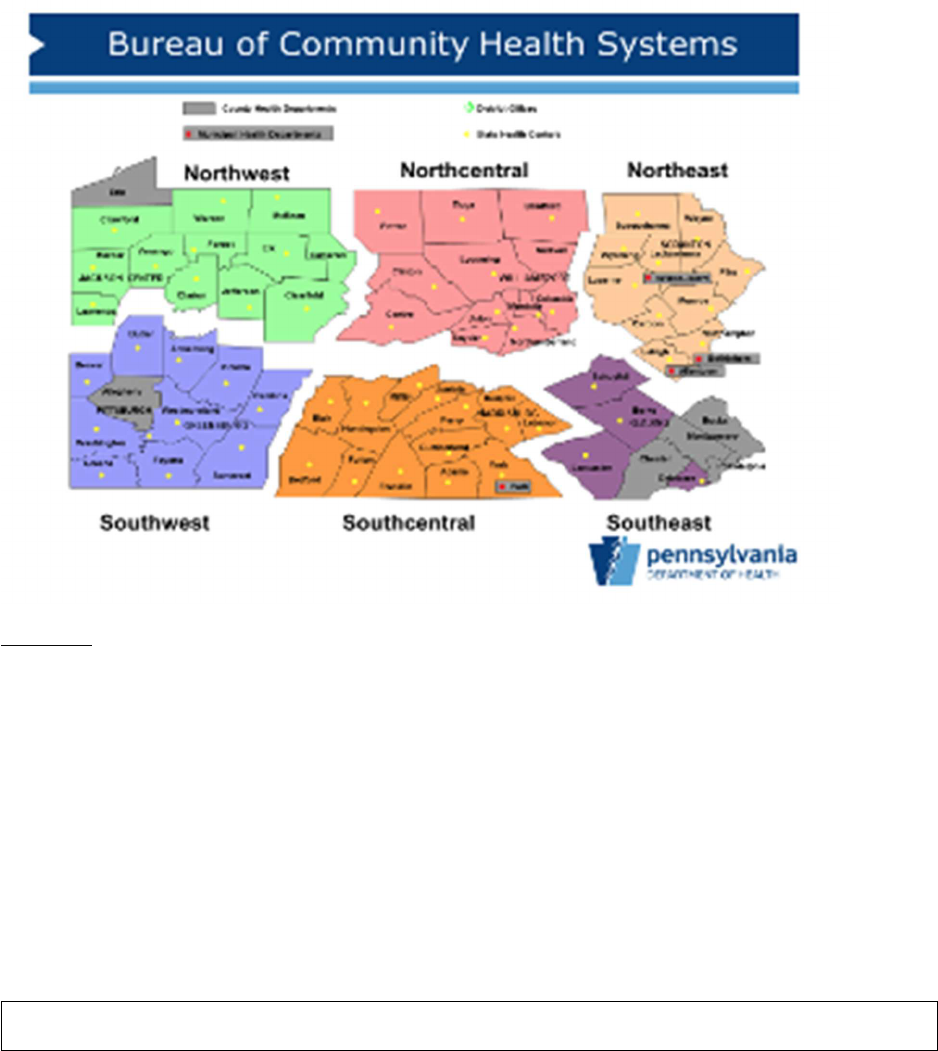
Overview: Version 1.0 (April 22, 2020
4
:00 PM)
The 2019 Novel Coronavirus (COVID-19) pandemic is an unprecedented event that has impacted every
part of the globe. Pennsylvania has seen a similar unprecedented burden of COVID-19 and has taken
equally unprecedented measures to save lives and reduce morbidity of the COVID-19 virus.
The commonwealth has responded aggressively to the spread of COVID-19, first by working to contain
the virus through contact tracing and quarantines for residents who came in contact with someone who
tested positive for the virus to slow sustained community spread. When sustained community spread
was established, the commonwealth moved to mitigation efforts early in the response by issuing orders
to close schools and non-life-sustaining businesses; and to restrict large gatherings. This decision to
respond aggressively has proven to be an essential and effective measure to reduce the spread of
COVID-19 and ultimately save an unrealized number of Pennsylvanians’ lives.
Mitigation efforts have helped to curtail the spread of COVID-19 so our hospitals can treat patients
without overwhelming our limited supplies of personal protective equipment (PPE), ventilators, or beds.
Throughout the pandemic, we have closely monitored our hospital system capacity through the creation
of a public dashboard, and we have built and distributed millions of goods and materials to help our
health care system manage the influx of patients.
PA DOH and PEMA have worked together to develop plans and stand up alternative care sites in the
northeast and southeast so when our health care system becomes overwhelmed, we can load balance
patients and supplies by keeping patient safety top of mind. At this point, alternative care sites have
been identified in other areas of the commonwealth and can quickly stand up should there be a surge in
other areas of the state.
As the situation stabilizes, we are planning a measured and strategic approach to allowing
Pennsylvanians to return to work safely to prevent a resurgence of the virus. This must be done in the
most effective, efficient, and risk-adverse method possible to balance our return to economic stability,
while at the same time continuing to keep Pennsylvanians safe by controlling the spread of disease.
We are planning for the days and weeks ahead when we will not only safely return Pennsylvanians to
work but return to a different and more resilient Pennsylvania. While we cannot be certain of the future
path of this disease, our decisions will be driven first by prioritizing the health and safety of all
Pennsylvanians.
To that end, the commonwealth is partnering with Carnegie Mellon University (CMU) to create a data-
driven decision support tool that will enable a balance between maximizing the results of our economy
while minimizing public health risks. This tool will help better understand the current health and
economic status, as well as the inherent risks and benefits to easing restrictions by sector and region.
In consultation with Team PA, PA DOH, PEMA, the Department of Community and Economic
Development, the Department of Labor & Industry, and others, the administration will develop guidance
for businesses, local governments, workers, and customers with the goal of guiding a safe and iterative
reopening process.

Pennsylvania plans to proceed with returning to work cautiously. Broad reopenings or reopenings that
are not structured around ongoing social distancing, universal masking, or other public health guidance
would likely result in a spike of cases and new stay-at-home and closure orders.
Throughout this process, the administration will have guidance in place to support best public health
practices. This guidance will reinforce and build on existing worker and building safety orders. It will also
be able to adapt to the changing nature of the pandemic, as well as lessons learned from communities
that return to work strategically.
Discussed in greater detail below, the administration will utilize a three-phase matrix to determine when
counties and/or regions are ready to begin easing some restrictions on work, congregate settings, and
social interactions.
The red phase, which currently applies to the whole state, has the sole purpose of minimizing the spread
of COVID-19 through strict social distancing, non-life sustaining business, school closures, and building
safety protocols.
Red
Work & Congregate Setting Restrictions
Social Restrictions
Life Sustaining Businesses Only
Congregate Care and Prison Restrictions
in Place
Schools (for in-person instruction) and
Most Child Care Facilities Closed
Stay at Home Orders in Place
Large Gatherings Prohibited
Restaurants and Bars Limited to Carry-
Out and Delivery Only
Only Essential Travel Encouraged
Reiterate and reinforce safety guidance for businesses, workers, individuals, facilities, update
if necessary
Monitor public health indicators, adjust orders and restrictions as necessary
As regions or counties move into the yellow phase, some restrictions on work and social interaction will
ease while others, such as closures of schools, gyms, and other indoor recreation centers, as well as
limitations around large gatherings, remain in place. This purpose of this phase is to begin to power back
up the economy while keeping a close eye on the public health data to ensure the spread of disease
remains contained to the greatest extent possible.
Yellow
Work and Congregate Setting Restrictions
Social Restrictions
Telework Must Continue Where Feasible
Businesses with In-Person Operations
Must Follow Business and Building Safety
Orders
Child Care Open with Worker and
Building Safety Orders
Congregate Care and Prison Restrictions
in Place
Schools Remain Closed for In-Person
Instruction
Stay at Home
Restrictions Lifted in Favor
of Aggressive Mitigation
Large Gatherings Prohibited
In-Person Retail Allowable, Curbside and
Delivery Preferable
Indoor Recreation, Health and Wellness
Facilities (gyms, spas), and all Public
Entertainment (casinos, theaters) Remain
Closed
Restaurants and Bars Limited to Carry-
Out and Delivery Only

All businesses must
follow CDC and DOH guidance for social distancing and cleaning
Monitor public health indicators, adjust orders and restrictions as necessary
The green phase eases most restrictions by lifting the stay at home and business closure orders to allow
the economy to strategically reopen while continuing to prioritize public health. While this phase will
facilitate a return to a “new normal,” it will be equally important to continue to monitor public health
indicators and adjust orders and restrictions as necessary to ensure the spread of disease remains at a
minimum.
Green
Work and Congregate Setting
Restrictions
Social Restrictions
All Businesses Must Follow CDC and PA
Department of Health Guidelines
Aggressive Mitigation
Orders
Lifted
All Individuals Must Follow CDC and PA
Department of Health Guidelines
Monitor public health indicators, adjust orders and restrictions as necessary
History
The first confirmed case of the 2019 novel coronavirus in the United States was reported in Washington
state on January 21; on January 30, the World Health Organization declared the virus a global health
emergency.
The Pennsylvania Department of Health (PA DOH) began daily leadership meetings on January 26, to
carefully track the disease, prepare a response, and coordinate with federal and hospital partners.
On February 1, PA DOH stood up its DOC, or Department Operations Center, on a 12 hour, 7 days a week
activation status at the Pennsylvania Emergency Management Agency (PEMA). Staffed by PA DOH
epidemiologists, public health nurses, physicians, logistical, planning and communication support, the
Pennsylvania Department of Human Services and PEMA to closely monitor the spread of the disease,
and begin containment strategies in furtherance of the state’s preparedness plans.
On March 4, due to the continued spread of the virus throughout the United States, PEMA partially
activated its Commonwealth Response Coordination Center (CRCC) to provide planning and logistical
support for PA DOH and to coordinate situational awareness across state agencies and all 67 counties
within the commonwealth.
On March 6, Pennsylvania recorded its first two cases of COVID-19 and Governor Tom Wolf signed a
Disaster Declaration to ensure the state had the resources and authority to plan the process of
containment and mitigation in Pennsylvania, assuring Pennsylvanians that the commonwealth was
prepared to face this crisis.
On March 7, PEMA elevated the activation level of its CRCC to a full activation during daylight hours to
provide for additional support for PA DOH and to coordinate planning and response operations across
state agencies and federal, state, and local jurisdictions.
From the beginning of the pandemic, the administration undertook a measured, regional strategy to
mitigation and containment, and protecting Pennsylvanians with the assurance that they could receive
testing and treatment for COVID-19 without any financial burden. Decisions and actions were taken on a
state, county, and regional basis in coordination with local elected officials, public health experts, and
other stakeholders.
On March 10, PEMA, with assistance from PA DOH, conducted a COVID-19 planning workshop and
tabletop exercise for all state agencies to discuss preparations, potential impacts, and agency Continuity
of Operations Plans (COOP) related to operations during a pandemic.
On March 12, with cases rising in Montgomery County, Governor Wolf closed schools and adult day
centers there for 14 days, requesting that non-essential businesses close and county residents limit
travel. He also imposed limited visitation in nursing homes and correctional facilities. The mitigations
would prove to be vital as cases increased in the Southeast over the next week.
On March 13, Governor Wolf announced that mitigation efforts would be extended to Delaware County
and all Pennsylvania schools would be closed for 10 days beginning March 16. Additionally, on March 13
the President of the United States issued a National Emergency, which included Emergency Disaster
Declarations for all 50 states for emergency protective measures for COVID-19 response operations that
was retroactive to January 20.
On March 14, with cases in Pennsylvania nearing 50, Governor Wolf announced additional closures in
Bucks and Chester counties.
On March 16, because of the continued spread of the virus across the commonwealth and increasing
case counts, PEMA began 24/7 operations of its CRCC in support of PA DOH and to maintain situational
awareness, coordinate resource support, and provide planning support across the state agencies and
federal, state, and local jurisdictions.
Under guidance from Health Secretary Dr. Rachel Levine, Governor Wolf ordered all Allegheny, Bucks,
Chester, Delaware, and Montgomery county bars and restaurants to cease dine-in operations beginning
March 16 for 14 days.
On March 18, PA DOH announced the first death from COVID-19 in the state.
On March 19, Governor Wolf ordered all non-life-sustaining businesses to close across the
commonwealth to help stop the spread of the virus. The administration provided guidance, refined
parameters, and designed an exemption process that could allow some businesses to remain open
under strict guidance from the state. Additionally, on March 19 the governor received notification of
approval of his request for a Small Business Administration (SBA) disaster declaration for the Economic
Injury Disaster Loan (EIDL) program to provide much-needed aid to businesses impacted by the COVID-
19 mitigation procedures.

On March 23, Governor Wolf and Dr. Levine began the process of issuing additional stay-at-home orders
based on county cases and modeling of the possible spread.
Timeline of County Stay-at-Home Orders:
March 23 Allegheny, Bucks, Chester, Delaware, Monroe, Montgomery, and Philadelphia
counties;
March 24 Erie County;
March 25 Lehigh and Northampton counties;
March 27 Berks, Butler, Lackawanna, Lancaster, Luzerne, Pike, Wayne, Westmoreland and York
counties;
March 28 Beaver, Centre, Washington counties;
March 30 Carbon, Cumberland, Dauphin and Schuylkill counties;
March 31 Cameron, Crawford, Forest, Franklin, Lawrence, Lebanon, Somerset counties; and,
April 1 Statewide Stay-at-Home Order.
As the administration issued stay-at-home orders, it also moved to make more materials available to
health care systems by working with the legislature to invest $50 million in support for hospitals and
health systems. The administration also worked with the legislature to move the primary election from
April 28 to June 2.
Federal support and aid have been critical in the state’s response. On March 29, to seek all available aid,
Governor Wolf requested a federal major disaster declaration. On March 31, the federal government
granted approval. Beginning with early assurances that COVID-19 testing and treatment would be
covered for all Pennsylvanians at no cost, Governor Wolf took additional steps to ensure everyone in the
state was treated fairly and without discrimination amid the pandemic.
On April 3, to reinforce mitigation and safety surrounding the COVID-19 pandemic, Governor Wolf called
for universal masking and requested that religious leaders consider alternate forms of worship.
Additionally, on April 3, Pennsylvania was one of the first states to receive statewide approval from the
Federal Emergency Management Agency (FEMA) to conduct non-congregate sheltering in response to
the COVID-19 emergency in the commonwealth.
On April 5, Governor Wolf announced that Dr. Levine issued an Order to make the buildings
Pennsylvanians work in safer.
To successfully mitigate a surge that could overwhelm the state’s health care system, the administration
sought information, capabilities, and needs from manufacturers that could ramp up to supply necessary
personal protective equipment (PPE) and others supplies. In addition, health care facilities began the
process of transferring supplies to help secure preparedness for those areas with greater needs. The
state issued an order for the ability to transfer supplies around the commonwealth, as necessary to load
balance the system.

On April 9, Governor Wolf announced the closure of schools through the end of the academic year and a
temporary reprieve program for non-violent state correctional facility inmates amid Department of
Corrections plans to keep inmates safe while incarcerated.
Communication and collaboration with other states have been vital as people typically travel between
neighboring states for work, to visit family, and to vacation under non-pandemic circumstances. On April
13, Governor Wolf joined six other governors (NY, NJ, CT, RI, DE, MA) in a council to plan how states can
work together to safely reopen and begin the process of recovery.
On April 15, the Secretary of Health issued an Order requiring safety measures in all businesses
permitted to maintain in-person, physical operations except for health care providers. These measures
included standards for cleaning and disinfecting high-touch areas, establishing protocols for businesses
exposed to a probable or confirmed case of COVID-19, limiting the numbers of employees and
customers on the premises, ensuring that employees have access to soap, sanitizer, and face masks, and
that patrons wear face masks.
On April 17, Pennsylvania was the first state to have a Memorandum of Understanding (MOU) accepted
by FEMA for purchasing and distributing food through established Food Banks in the commonwealth.
Also, on April 17, Governor Wolf outlined the standards the administration will use for reopening and on
April 20, Governor Wolf announced a target date of May 8 for the beginning of phased reopening and
easing of restrictions.
Standards
Our approach will be data driven and reliant upon quantifiable criteria to drive a targeted,
evidence-based, regional approach to reopenings in Pennsylvania.
We will put forth guidance and recommendations for employers, individuals, and health care
facilities and providers for assured accountability as we reopen.
Reopening necessitates that adequate personal protective equipment and diagnostic testing are
available.
Reopening requires a monitoring and surveillance program that allows the commonwealth to
deploy swift actions for containment or mitigation.
Protections for vulnerable populations must remain steadfast throughout the reopening
process, such as limitations on visitors to congregate care facilities and prisons.
Limitations on large gatherings unrelated to occupations should remain in place for the duration
of the reopening process.
Our approach will be data driven and reliant upon quantifiable criteria to drive a targeted,
evidence
-
based, regional approach to reopenings in
Pennsylvania.

To make decisions about what regions to reopen, and on what timeline, the commonwealth has
partnered with Carnegie Mellon University and other institutions of higher education, to develop a data
dashboard which will help inform decisions. This dashboard, as well as demographic and health criteria
described further below, such as population density, and mobility, availability of testing, and health care
resources will inform formal recommendations made jointly by the Secretary of Health, the PEMA
Director, and the Secretary of the Department of Community and Economic Development to the
Governor regarding when a region may safely move from one phase of reopening to the next. In
preparing recommendations, the Secretaries and PEMA Director will meet to review the data sources
described more fully below, balance risks to public health, and benefits to the economy, and agree
unanimously as to the phase in which each region will safely be categorized.
First, PA DOH in coordination with PEMA, other commonwealth agencies, and stakeholders in the areas
of public health, economics, and emergency management has developed criteria that will help guide
decisions about reopenings and the easing of restrictions.
To determine when a region is ready to reopen and return to work, we will evaluate the incidence rate
of COVID-19 cases per capita. We will rely upon existing regional health districts used by PA DOH. A
regional assessment will measure the COVID-19 cases per the population, and will need to be an
average of less than 50 cases per 100,000 individuals over the course of 14 days to return to work. The
administration will work closely with county and local governments to enable the communities to
reopen and transition back to work. Additionally, to reopen a region, the commonwealth must ensure
there is:
Enough testing available for individuals with symptoms and target populations such as those at
high risk, health care personnel, and first responders.
Robust case investigation and contact tracing infrastructure is in place to facilitate early
identification of cluster outbreaks and to issue proper isolation and quarantine orders.
Identification of area’s high-risk settings including correctional institutions, personal care
homes, skilled nursing facilities, and other congregate care settings, and assurance that facilities
have adequate safeguards in place such as staff training, employee screening, visitor procedures
and screening, and adequate supplies of PPE to support continued operations.
Second, the commonwealth will use a modeling dashboard under development and evaluation by
Carnegie Mellon University to take a regional and sector-based approach to reopenings, the easing of
restrictions, and response.
The administration will use this data-driven decision support tool to better understand the current
health and economic status, as well as the inherent risks and benefits to reopening certain businesses
and industry areas. Using data that considers worker exposure and spread risks, health care capacity,
economic impact, and supply chain impact, we will prioritize reopening where it has the potential for
the most positive impact on the economy for workers and businesses while mitigating risk to public
health and safety.
In order to arrive at results through this dashboard, the Commonwealth of Pennsylvania is providing
access to data from several commonwealth agencies including the Departments of Labor & Industry,
Human Services, Community and Economic Development, Revenue, and Health.

The dashboard will help with questions such as: What will be the likely public health and economic
implications associated with opening an industry? What impact might reopening have on vulnerable
workers and businesses? The data from the dashboard will also provide insights and recommendations
at the industry and county level to inform state policy decisions.
The analysis will link data sources together to build an understanding of the current and real time state
of Pennsylvania’s economy and the impact of the spread of COVID-19. The model will help to predict
and understand what types of individuals, businesses, and industries will be more at risk, most
vulnerable, and impacted by COVID-19. The model will apply what-if scenarios that will allow the state
to understand the impact of potential re-opening decisions. The analysis will allow the commonwealth
to monitor changes over time and the impact of decisions. The purpose is not to make decisions but
rather to inform decision makers. For example, all indicators could point to opening a specific county,
but other factors such as population density around a hotspot, availability of supplies to ensure workers
are protected, either PA DOH criteria or proximity to a hotspot in another county could make the county
unfit to open.
Regions
Just as the administration took a measured, county-by-county approach to the Stay at Home order
before expanding the order statewide, it will do the same to ease restrictions and reopen the state.
As regions meet the measures described earlier, the commonwealth will ease restrictions with the goal
of broad reopenings as soon and as safely as possible. Certain regions have seen less case density than
others. In these regions, it is important to account for hospital capacity as reopenings and the easing of
restrictions begin. This information is part of the data and modeling project. For example, in the north
central region there is less population density and fewer cases, but there is less hospital capacity if cases
and hospitalizations were to surge. These factors will be considered on an ongoing basis and employers
will be responsible for developing and demonstrating compliance with criteria in consultation with PA
DOH and other relevant state agencies. At any point, the Governor, in consultation with PA DOH and
PEMA may revise reopening standards to adjust for the spread of disease.

Industries
The reopening and the easing of restriction approach will primarily focus on regions, however certain
industries are more susceptible to the spread of COVID-19. Other industries are more vulnerable to
changing economic conditions. These factors are also part of the data and modeling project and will be
closely considered as part of the reopening and the easing of restriction process. The first or “Yellow”
phase of reopening will focus on businesses with low and moderate risk profiles, including those with
low worker density, those that take place in outdoor settings, and those that can successfully implement
the Governor and Secretary of Health’s Worker Safety and Building Safety Orders, while encouraging
those who can telework to continue to do so (see later section on “Phases”). When reopened, these
businesses will have to adhere to strict guidelines for density and procedures. The administration will
work with stakeholders in various industry sectors, as well as labor representatives and health
professionals to craft guidance with tailored and appropriate safeguards in place.
We will put forth guidance and recommendations for employers, individuals, and health care
facilities and providers for assured accountabili
ty as we reopen.
Since the beginning of the pandemic, the Wolf Administration has provided general safety guidance for
businesses, organizations, and individuals. As the administration begins the reopening and the easing of
restriction process, this guidance will be refined and strengthened so businesses and organizations can
continue to prioritize public health and safety while attracting new business and getting the economy
back on track.

All Pennsylvanians should continue to maintain social distancing even as the reopening and easing of
restriction process begins. With few exceptions, Pennsylvanians should maintain a distance of six feet
from each other, gatherings of more than 10 people will be prohibited, and non-essential travel should
be avoided. In addition, individuals should engage in frequent hand washing and sanitizing, and surfaces
should be disinfected as often as possible.
For employers, remote or telework should be the primary option if possible. Employers should expand
technology where possible to provide remote or telework options. If remote or telework are not
possible, employers must follow the guidance developed by the commonwealth in order to reduce the
risk of coronavirus spread and to ensure workers are kept safe.
Guidance
Working across agencies, the commonwealth is providing broad guidance for businesses and individuals
that will enable employers to use their own expertise to decide what is best for their business while
reporting on outcomes to the commonwealth. This guidance re-emphasizes and builds on existing
orders previously issued to protect employees and customers, specifically the building safety and
workers’ safety orders. The guidance formalizes and builds on CDC recommendations and other best
practices in states across the country.
Communicating COVID-19 Safety Procedures to Employees and Customers
Organizations will be required to make employees and customers aware of the guidance provided by the
commonwealth to keep people at their establishment safe. Similar to Workers’ Compensation or OSHA
regulations, the commonwealth will require commonwealth-created “COVID-19 Safety Procedures for
Businesses” flyer to be clearly displayed at workplaces, along with publicly posted acknowledgement by
the employer that the guidance is being followed. There is also a requirement to name a “Pandemic
Safety Officer” who would be in charge of carrying out the COVID-19 safety procedures set forth in this
guidance.
The business reopening guidance will provide more information about expectations for communicating
safety procedures to employees and customers.
Supplier Directory
The administration recognizes the difficulty of procuring materials businesses need to safely resume
operations. In order to address this concern, the Department of Community and Economic Development
created a supplier directory for protective materials.
To view the supplier directory, please visit: https://dced.pa.gov/pennsylvania-covid-19-ppe-supplies-
business-2-business-b2b-interchange-directory/
Reopening necessitates that adequat
e personal protective equipment and diagnostic testing are
available.
Personal Protective Materials and Hospital Stockpiles

Ensuring adequate supplies of Personal Protective Equipment (PPE) and other supplies needed to
conduct diagnostic testing, care for COVID-19 patients, and support other normal health care functions
is critical to resuming normal operations. The global nature of the COVID-19 pandemic has adversely
impacted the normal supply chain for these materials as the demand has significantly outpaced the
ability to produce or acquire the PPE and supplies needed. Since early March the Wolf Administration
has worked tirelessly to procure and distribute PPE and other supplies to hospital systems, long-term
care facilities, first responders and emergency management agencies throughout the commonwealth to
respond to the COVID-19 crisis
As of April 22, the Wolf Administration has distributed 3 million N95 masks, approximately 231,000
gowns, approximately 1.36 million procedure masks, more than 1.32 million gloves, more than 68,000
face shields, and more than 5,300 coveralls to more than 900 unique places.
The Wolf Administration continues to monitor PPE and stockpile levels at our health systems, and takes
that information into consideration as it makes decisions.
Diagnostic Testing
As of April 21, 2020, over 163,000 Pennsylvanians have been tested for COVID-19 at 67 unique testing
sites, including our own State Public Health laboratory and two county public health labs. Over 700 tests
a day can be done at the PA DOH State Public Health laboratory and PA DOH has deployed 14 rapid
testing machines to vulnerable congregate settings including correctional facilities and health care and
state hospitals. Additionally, during the course of the pandemic, the Wolf Administration supported the
establishment of three community-based testing sites which were located in Montgomery, Philadelphia,
and Luzerne counties. The Luzerne County site is currently open and can test up to 250 people per day.
As the administration takes steps toward reopenings and the easing of restrictions, diagnostic testing
capacity will be a critical factor in early identification of new infections or cluster outbreaks, changes in
the spread of the virus, the extent of virus spread throughout the commonwealth, and whether healthy
individuals who were previously exposed to the virus have developed immunity.
The testing plan will consist of a multilayered approach comprised of the following components:
1. Community based testing available through:
a. Existing health care institutions;
b. State managed, locally executed community based or mass testing sites; and,
c. Corporate managed and supported testing sites such as those available through
commercial pharmacies and other providers.
2. Point of Care (POC) testing available through:
a. Primary Care Physicians (PCP);
b. Hospital Emergency Departments, urgent care, or other acute care centers;
c. County health departments;
d. Institutions with congregate care settings that have their own health care capability;
and,
e. Outbreak response teams responding to congregate care settings to identify spread of
virus within institutions.

3. Serology testing as it becomes commercially available to determine the extent of the population
that may have been exposed to COVID-19 and have developed antibodies to the virus and
potentially have immunity.
The above testing strategy will also include a plan to test underserved populations and those that have
limited availability of transportation by employing a mobile community-based testing strategy as
applicable.
More information about coronavirus testing in the commonwealth can be found here -
https://www.health.pa.gov/topics/disease/coronavirus/Pages/Symptoms-Testing.aspx
Reopening requires a monitoring and surveillance program that allows the commonwealth to
deploy swift actions for containment
or mitigation.
The administration will use the data and modeling tools available as well as other indicators to
determine if changes in the reopening and the easing of restriction process must take place.
Robust surveillance, case investigation, contact tracing, and isolation of positive cases or quarantine of
close contacts can slow and stop the transmission of COVID-19. Pennsylvania’s public health
infrastructure of epidemiologists, community health nurses, and county and municipal health
departments are the backbone of this work. These public health professionals are supported by
surveillance and case management technology tools to track, manage, and evaluate efforts.
To scale our surveillance and monitoring infrastructure the commonwealth has:
Partnered with Department of Human Service’s eHealth Authority and the regional Health
Information Exchange to monitor rate of emergency department visits and inpatient admissions.
Established alerts from EpiCenter, Pennsylvania’s syndromic surveillance system, for early
identification of an increase in disease activity.
Provided county-level and zip code level data through a public facing dashboard:
https://experience.arcgis.com/experience/bc92e33cfd5d417795f7a7a1a5cb3b1d/.
Daily detailed analysis of surveillance data related to cases and test results, analysis of
geospatial clusters of cases.
Twice weekly reconciliation with surveillance data and electronic death data to provide more
accurate counting of deaths related to COVID-19.
Improving access to testing and timeliness for reporting for symptomatic close contacts in
regions where this containment strategy is being implemented.
As counties return to work the department will use these tools and the complete case investigation and
contact tracing of positive cases to stamp out disease transmission. Positive cases will be isolated, and
their close contacts counseled and quarantined. The department will continue to conduct investigations
of outbreaks at businesses, correctional facilities, and long-term or other congregate care facilities. This
work will be done in partnership with local health departments and other health care infrastructure in
the region. Existing public health systems and new technology tools will be utilized to support these
boots on the ground efforts.

Protections for vulnerable populations must remain steadfast throughout the reopening process,
such as limitations on visitors to congregate care
facilities and prisons.
Pennsylvanians in congregate care and prisons are especially vulnerable to outbreaks. Until the
pandemic is controlled, the commonwealth must continue measures designed to protect outbreaks in
facilities like nursing homes, long-term care facilities, residential treatment facilities, and prisons. As the
commonwealth reopens and eases restrictions on a regional basis, restrictions on visitors in congregate
care settings and prisons will remain in place. These restrictions will be among the last restrictions eased
to ensure resident health and safety. We are committed to alternative means of communication for
residents with their family, friends, community members, and advocates while we take necessary health
and safety precautions.
While the administration has needed to take unprecedented action in limiting visitation for vulnerable
populations in congregate care settings, we are doing all we can to create new opportunities for social
connectedness. For example, the Department of Aging through its Office of the Long-Term Care
Ombudsman has developed a strategic partnership with the AARP to re-establish lines of
communication with nursing home residents in targeted facilities throughout the commonwealth. As
this disaster emergency continues over the next weeks and months, this critical technology, when
strategically placed, will help meet the psychosocial needs of these already vulnerable individuals.
Congregate Care Facilities
On March 16, the Department of Human Services closed LIFE day centers to avoid congregate settings
and to practice social distancing. The closure applies to the day center portion only. LIFE Provider
Organizations should continue to use discretion when utilizing the clinic and therapy areas to see
participants. FAQs are provided at
https://www.dhs.pa.gov/providers/Providers/Documents/Coronavirus%202020/LIFE%20COVID-
19%20FAQ%20v1.pdf.
On March 18, PA DOH issued guidance for nursing facilities on COVID-19 mitigation. This guidance
required visitor limitations, personnel restrictions, and other measures to reduce the spread of COVID-
19 in nursing facilities. This guidance will continue.
https://www.health.pa.gov/topics/Documents/Diseases%20and%20Conditions/COVID-
19%20Interim%20Nursing%20Facility%20Guidance.pdf
On March 29, the Department of Human Services issued guidance restricting all visitations in Personal
Care Homes and Assisted Living Residences except for medically necessary visits and compassionate
care situations, such as end-of-life situations. This guidance will continue.
https://www.dhs.pa.gov/providers/Providers/Documents/Coronavirus%202020/OLTL_License_Guidanc
e%203.29.20.pdf
On March 31, the Department of Human Services issued guidance for residential providers under the
Office of Mental Health and Substance Abuse Services including Long-Term Structured Residences,
Community Residential Rehabilitation Services, Residential Treatment Facilities, and Crisis Residences

recommending all providers develop temporary modifications to their visitation policies that prohibit all
non-employee visitors unless it is a medical necessity, required by court order, adult protective services
or older adult protective services staff as outlined in guidance issued under applicable protective
services laws. At the discretion of the facility director, additional exceptions may be made where a visit
is deemed to be necessary This guidance will continue.
https://www.dhs.pa.gov/providers/Providers/Documents/Coronavirus%202020/Final%20OMHSAS%20R
TF%20LTSR%20CRR%20Visitation%20Guidance%203.31.20.pdf
On April 4, the Department of Human Services temporarily suspended all transfers to state-run juvenile
justice facilities. This step was taken to allow staff to create two ten-bed intake units to mitigate risk of
spread at the state-run facilities. Youth awaiting transfer to the state-run juvenile justice system will be
admitted to the intake unit on the same day and remain in the unit for 14 days until they are cleared for
entry into their designated program. If any youth test positive for COVID-19 during this 14-day period,
they will be moved into isolation and the youth who are in the intake unit will restart their 14 days in the
unit to make sure that they do not develop symptoms of COVID-19. Youth in the intake unit will have
access to a counselor, psychological and medical services, physical activity, and other individualized
recreational activities. Social distancing will be enforced, and youth will be able to maintain contact with
their family through phone calls, video conferencing, and letters. The previously issued guidance will
continue.
https://www.dhs.pa.gov/providers/Providers/Documents/Coronavirus%202020/BJJS%20Intake%20Unit
%20Guidance.pdf.
On April 7, the Department of Human Services issued procedures that must be followed for admission of
an individual to one of the department’s state facilities. Requirements include individuals be screened
for COVID-19 prior to admission to state operated psychiatric hospitals, the long-term care facility
(South Mountain Restoration Center), state centers, and Youth Development Centers or Youth Forestry
Camps. Any individual who meets screening criteria for indication of infection but does not have
documentation of a negative test result for COVID-19, may not be admitted. A medical clearance
attestation from a physician within 72 hours prior to the requested admission date is acceptable for
admission if the individual was screened with a negative result. If there was a positive screening,
regardless of a COVID-19 test result, the individual must not be admitted until 7 days have passed since
symptom onset, and 3 days (72 hours) after the resolution of fever without fever reducing medicines
and improvement of other symptoms. If an individual has had a close contact with someone suspected
to have, or diagnosed with, COVID-19, the individual should quarantine for 14 days from the last
admission to a facility should not occur until after the 14-day quarantine is complete. This guidance will
continue.
https://www.dhs.pa.gov/providers/Providers/Documents/Coronavirus%202020/COVID19%20DHS%20Pr
otocol%20for%20State%20Facilities_Admissions%204.7.2020.pdf
State Correction Institutions
On March 12, the DOC started their mitigation efforts by screening all staff across the state and canceled
in person visitation before statewide mitigation was ordered. On March 28, the DOC shifted all new
inmate intakes to one centralized location at SCI Retreat to allow for a period of quarantine before
assigning their home institution.

At 10 p.m. on March 29, the DOC began a statewide inmate quarantine in response to the COVID-19
pandemic.
Since the quarantine began, inmates have been fed in their cells, and afforded out-of-cell time only for
video visits, phone calls, access to the law library, as well as in-cell programming. All inmate movement
is controlled to conform to social distancing recommendations. This guidance will continue.
To expand inmate interaction with their loved ones, video visits are being held seven days a week. To
date, DOC has conducted almost 16,000 video visits with more scheduled every day. This number will
continue to increase due to daily scheduling happening at state prisons. In addition, DOC officials have
begun reducing the population where they can. Steps taken include:
Furloughing paroled individuals from centers to home plans;
Working with the parole board to maximize parole releases; and,
Reviewing parole detainers for individuals in county jails and state prisons.
On April 10
th
, the governor issued reprieves for inmates who met criteria for the Temporary Program to
Reprieve Sentences of Incarceration.
To learn more about the comprehensive mitigation efforts in state correction institutions, visit:
https://www.cor.pa.gov/Pages/COVID-19.aspx.
Limitations on large gatherings unrelated to occupa
tions should remain in place for the duration of
the reopening process.
At this time, the commonwealth continues to follow federal guidance on restrictions on large
gatherings. The CDC continues to recommend against gatherings of 10 or more individuals, particularly
gatherings where vulnerable populations may be present. This guidance will stay in place for the
duration of the reopening process until there is robust testing, community-wide surveillance, contact
tracing, or other means to mitigate the spread of the virus.
Support Systems
As reopenings and easing of restrictions begin, we need to provide adequate support systems for
workers. That includes reopening of programs that support individuals’ ability to return to work such as
schools, child care facilities, adult day facilities, summer camps and afterschool programs, community
recreational facilities, and more.
Child Care
The COVID-19 related school closure has created a gap in child care that may not have existed just a few
months ago. We know this gap may potentially be a barrier for many Pennsylvanians preparing to
transition back to work outside of the home. To address this barrier, the Departments of Education and
Human Services are working with stakeholders to identify child care and school age care needs across

the commonwealth. A primary focus will be exploring and creating options that will work best for
families within their community. We will also look to our many partners to help us design a realistic plan
that not only re-opens and expands these services if necessary, but also creates a restored sense of
confidence in these environments as safe and healthy options when caregivers return to work.
K-12 Schools
On April 9, Governor Wolf and the Pennsylvania Department of Education announced that school
buildings would be closed for the remainder of the 2019-2020 academic year. The Department of
Education worked with Intermediate Units (IUs) and the Pennsylvania Training and Technical Assistance
Network (PATTAN) to develop guidance and evidence-based resources around continuity of education
to ensure all schools provide continuity of education for all students in the most accessible and
appropriate ways possible. Working with the General Assembly, the Governor signed Act 13 of 2020 to
waive the School Code requirement for a minimum 180-day school term, an action that builds on the
administration’s earlier commitment that no district or school would be penalized for falling short of the
180-day school term requirement.
In addition, Pennsylvania sought and received approvals from the federal government to allow schools
the option to distribute meals to children age 18 and under at no cost while schools are closed. Although
not required, participating schools are strongly encouraged to continue distributing and/or delivering
school meals during breaks.
Higher Education
On April 9, the Governor and the Pennsylvania Department of Education announced that all
postsecondary institutions in Pennsylvania must suspend in-person instruction at least through the end
of the spring 2020 term. Postsecondary institutions may not resume in-person instruction until the
governor permits them to open or lifts the closure of non-life-sustaining businesses.
Government Services
Local Government
Since the beginning of the COVID-19 outbreak, the Governor’s Office has been in close collaboration
with local leadership at the county and municipal level. Early on, the Governor’s Office consulted with
and informed county commissioners and municipal leadership about starting mitigation efforts in their
jurisdictions. The Governor’s Office shared public health concerns and information and took local
feedback into account when making decisions around mitigation. This collaboration led to a strong,
coordinated effort to prevent the spread of COVID-19 across the commonwealth.
As we look to reopen regions of the commonwealth, the Governor’s Office will be undertaking that
same coordinated approach to relaxing the governor’s mitigation efforts. Local feedback, knowledge,
and expertise will be critical as we move through all phases of reopening. The Governor’s Office will
continue to coordinate with local officials directly, when appropriate, and through their statewide
representative organizations.
In the 10 jurisdictions with local county or municipal health departments, PA DOH will continue to
coordinate closely with local health officials to ensure that there is a shared understanding of the public

health rationale behind reopening decisions. In the remaining areas without countywide health
departments, PA DOH will continue to discuss public health realities directly with county commissioners.
The shared goal of the state and local governments is, and should continue to be, a united front in which
all levels of government are prepared to lead the citizens of Pennsylvania through this pandemic and to
a safe, efficient, and effective reopening.
State Government
The COVID-19 global pandemic has created an unprecedented situation within our workforce. The
Commonwealth is not excluded from this as it is the second-largest employer in the state. Throughout
the COVID-19 crisis, state workers have continued to provide essential services to ensure public safety
and the public health of all Pennsylvanians, specifically our most vulnerable populations. Roughly 43,000
employees continue to report onsite daily to perform vital work while roughly 18,000 employees remain
teleworking in a full-time capacity.
As the state looks to reopen, it will do so in a phased approach in consultation with PA DOH. Bringing
back our workforce and reopening public-facing offices at the appropriate time will be done through
cooperation with state agencies, employees, and our unions. The staff that is already teleworking will be
encouraged to do so where appropriate. Social distancing and facility cleaning measures will be in place
to protect both staff and customers. Staff working onsite will be required to wear a mask.
Phases
As we progress through the process of reopening and the easing of restrictions, we will work in phases,
taking a regional approach, with the expectation that this will not necessarily be a linear process. If
indicators and criteria point to a spike in cases, the commonwealth, in coordination with local officials,
will need to revert to previous restrictions and orders. Throughout all phases, there must be strict
guidance in place to encourage social distancing.
Throughout this process, the commonwealth will remain flexible and respond to the conditions on the
ground in specific areas. The commonwealth will work with local governments to help inform and make
decisions that are best for their communities.
The phases were developed through the commonwealth’s six standards for reopening as well as the
federal government’s Opening Up America Guidelines. The phases are intentionally expansive to allow
for flexibility and decisions will be driven by health indicators as well as the Carnegie Mellon University
data tool and metrics from the Department of Health to determine safety for regions and industries
taking into account economic vulnerability. *Within each of these phases there could be additional
actions, orders, or guidance depending on the public health and economic conditions facing regions or
counties.*
Red
Work
& Congregate Setting
Restrictions
Social Restrictions
Life Sustaining Businesses
Only
Stay at Home Orders
i
n Place
Large Gatherings Prohibited

Congregate Care and Prison Restrictions
in Place
Schools (for in-person instruction) and
Most Child Care Facilities Closed
Restaurants
and
B
ars
Limited to C
a
rry
-
Out and Delivery Only
Only Essential Travel Encouraged
Reiterate and reinforce
safety guidance for businesses, workers, individuals, facilities, update
if necessary
Monitor public health indicators, adjust orders and restrictions as necessary
Yellow
Work
and Congregate Setting
Restrictions
Social Restrictions
Telework
Must
Continue
Where
Feasible
Businesses with In-Person Operations
Must Follow Business and Building Safety
Orders
Child Care Open with Worker and
Building Safety Orders
Congregate Care and Prison Restrictions
in Place
Schools Remain Closed for In-Person
Instruction
Stay at Home Restrictions Lifted in Favor
of Aggressive Mitigation
Large Gatherings Prohibited
In-Person Retail Allowable, Curbside and
Delivery Preferable
Indoor Recreation, Health and Wellness
Facilities (gyms, spas), and all Public
Entertainment (casinos, theaters) Remain
Closed
Restaurants and Bars Limited to Carry-
Out and Delivery Only
All businesses must follow
CDC and DOH guidance for social distancing
and cleaning
Monitor public health indicators, adjust orders and restrictions as
necessary
Green
Work and Congregate Setting
Restrictions
Social Restrictions
All Businesses Must Follow CDC
and PA
Department of Health Guidelines
Aggressive Mitigation Orders Lifted
All Individuals Must Follow CDC and PA
Department of Health Guidelines
Monitor
p
ublic
h
ealth
i
ndicators
, adjust orders and restrictions as necessary
